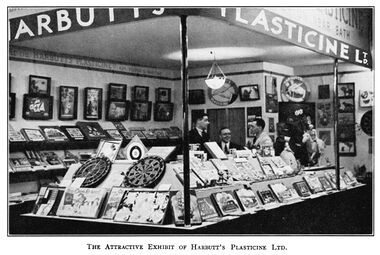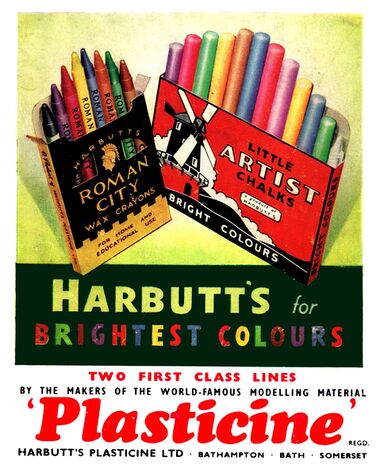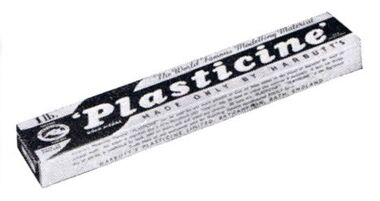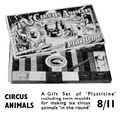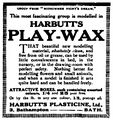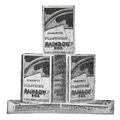Category:Harbutt
| Toy Brands and Manufacturers |
|---|
Harbutt |
| 1897 - |
1939: The Harbutt's Plasticine stand at the British Industries Fair ("BIF") in early 1939 (or late 1938?) [image info]
1956: Harbutt's for Brightest Colours", "Roman City" wax crayons (probably a reference to the company's location in Bath) and "Little Artist" chalks [image info]
1963: Harbutt's Plasticine 1lb pack [image info]
Harbutt's Plasticine Limited ("HPL") was born out of William Harbutt's perfection in 1897 of Plasticine, a non-drying alternative to modelling clay.
Harbutt immediately started promoting the new material with advertising and a supporting book, and is supposed to have been granted a patent for the new material in in 1899.
After originally making small batches in his basement. Harbutt moved production to a proper factory site at the old mill in Grange, High Street, Bathampton.
The business expanded internationally and the Harbutt's range started to include character tie sets for Disney creations and Enid Byton's Noddy.
The factory was accidentally burned down by a contractor in the winter of 1962/1963, but the company rebounded quickly, and with an in-demand product, when eventually brought down Harbutt's was mismanagement: William Harbutt had died from getting a chill in 1921 during a foreign demonstration tour, and left behind a large family who then rand the business. Although the Plasticine business was sound, some family members had decided that they wanted to do more, and diversified the company into other products that weren't as successful.
Products
Art/marking products
- Acorn weather-resistant marking crayons
- Little Artist chalks
- Plasticine
- Roman City wax crayons
- Novlart / Colour Stencilart / Easyart stencil art packs
Other products
- Morell's Inks, Chalks, Pastes and Sealing Wax – distribution had been taken over by Harbutt's by 1939
- Plastone self-hardening modelling clay
- Plasticine Dartboards (!)
- Replicars plastic snap-together car kits
Law
The company briefly made case law with "Plasticine" Ltd v Wayne Tank and Pump Co Ltd, in which it successfully got damages from a contractor despite a limiting clause in their contract. The contractor was apparently employed to install a piping conduit system for hot wax, decided to use plastic pipes, installed a faulty thermostat, and then switched on the system at night without supervision. The overheated hot wax melted through the plastic pipes, flooding the factory with molten wax, and then (predictably), caught fire, the resulting ultra-fierce blaze utterly destroying the factory and factory building.
Where "breach of condition" arguably undermined a contract by depriving one party of the advantages that the contract was supposed to ensure, Denning's new concept of "fundamental breach" went further, and said that if the complainant received none of the advantages meant from the contract, and also suffered serious harm from the defendant's behaviour, that the defendant could not hide behind "limitations" clauses in the contract to avoid being sued. WTPC's contract to build a piping system did not protect them from liability from multiple layers of negligence that resulted in the destruction of their client's factory. This new concept of "fundamental breach" was not generally considered to be good law, and did not "stick".
Addresses
- Harbutt's Plasticine Limited – 3 Bathampton, Bath (~1916)
- Harbutt's Plasticine Limited – 99 Bathampton, Bath
- Harbutt's Plasticine Limited – 79 Bathampton, Bath
- London Office and Showrooms – 56 Ludgate Hill, London EC4
External links and sources
- William Harbutt, Harbutt's plastic method: and the use of plasticine in the arts of writing, drawing, & modelling in educational work (Chapman & Hall, 1897)
Subcategories
This category has the following 5 subcategories, out of 5 total.
Pages in category ‘Harbutt’
This category contains only the following page.
Media in category ‘Harbutt’
The following 36 files are in this category, out of 36 total.
- Are you a Model Mother, Plasticine advert (MM 1966-10).jpg 2,001 × 1,407; 781 KB
- Brilliant Box, Harbutts Plasticine (MM 1928-12).jpg 1,328 × 747; 628 KB
- Circus Animals Pack, Harbutts Plasticine (Hobbies 1966).jpg 1,596 × 1,497; 890 KB
- Hands Full of Pleasure, Plasticine (GaT 1956).jpg 1,847 × 3,000; 740 KB
- Handy One-Colour Pack, Harbutts Plasticine (MM 1964-12).jpg 2,225 × 1,505; 425 KB
- Harbutt's Plasticine (MM 1963-10).jpg 470 × 835; 82 KB
- Harbutt's Plasticine, Meccano (MM 1938-11).jpg 577 × 1,470; 227 KB
- Harbutts Plasticine (MM 1950-06).jpg 2,067 × 3,000; 1.78 MB
- Harbutts Plasticine Builder (Hobbies 1916).jpg 2,000 × 1,253; 913 KB
- Harbutts Plasticine for modellers and woodcarvers (HW 1913-07-06).jpg 1,800 × 760; 502 KB
- Harbutts Plasticine pack (MM 1963-10).jpg 467 × 247; 42 KB
- Harbutts Plasticine, British Industries Fair exhibition stand (GaT 1939-04).jpg 3,000 × 2,016; 2.98 MB
- Harbutts Plasticine, How to Model (MM 1932-04).jpg 709 × 955; 101 KB
- Harbutts Plasticine, logo (1913).jpg 1,550 × 1,150; 328 KB
- Harbutts Plasticine, logo (1914).jpg 1,750 × 650; 139 KB
- Harbutts Plasticine, logo (1939).jpg 1,800 × 432; 124 KB
- Harbutts Plasticine, range (GAT 1939-11).jpg 2,243 × 3,000; 1.08 MB
- Harbutts Plasticine, Roman City, Little Artist (GaT 1956).jpg 1,277 × 1,600; 312 KB
- How To Model, Cow and Goat, Harbutts Plasticine (MM 1932-04).jpg 1,040 × 729; 377 KB
- How To Model, Horse and Cat, Harbutts Plasticine (MM 1931-09).jpg 905 × 635; 337 KB
- HPL logo, Harbutts Plasticine Ltd (~1948).jpg 478 × 497; 20 KB
- James Mays Toy Stories, cover and spine (ISBN 9781844861071).jpg 1,451 × 1,600; 1.39 MB
- Plasticine (MM 1967-07).jpg 886 × 1,200; 412 KB
- Plasticine Builder, Harbutts Plasticine (Hobbies 1916).jpg 1,532 × 1,046; 895 KB
- Plasticine Dartboards, Harbutts (GaT 1939-04).jpg 3,000 × 1,983; 1.8 MB
- Plasticine Designer, box art (MM 1927-12).jpg 1,410 × 1,038; 845 KB
- Plasticine, One Pound Carton (Hobbies 1966).jpg 1,620 × 709; 396 KB
- Plastone modelling material, Harbutts (Hobbies 1952).jpg 1,889 × 2,643; 1.6 MB
- Plastone modelling material, logo.jpg 1,265 × 369; 199 KB
- Plastone permanent modelling material, Harbutts (MM 1965-10).jpg 2,040 × 1,377; 459 KB
- Play-Wax, Harbutts (Strand ~1916).jpg 751 × 800; 347 KB
- Rainbow Box, Harbutts Plasticine, box artwork (MM 1927-11).jpg 1,350 × 1,345; 659 KB
- Replicars, Harbutts (MM 1969-04).jpg 1,227 × 889; 686 KB
- Replicars, Harbutts, box art (MM 1969-04).jpg 953 × 1,200; 480 KB
- Scowling Man, Plasticine photogrammetry test (2019-04).jpg 880 × 879; 97 KB
- The Complete Modeller, Harbutts Plasticine (MM 1938-11).jpg 338 × 246; 45 KB

